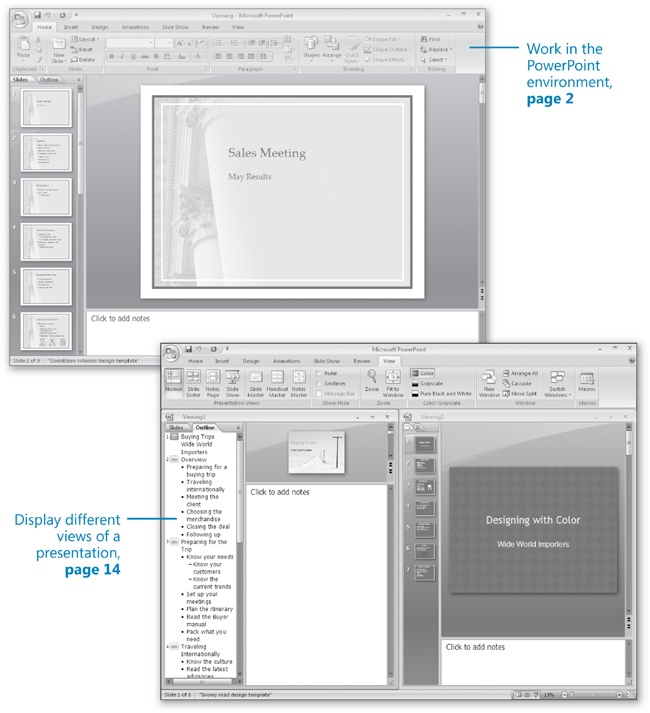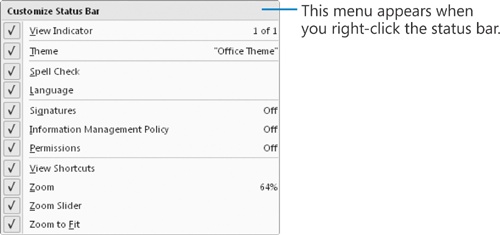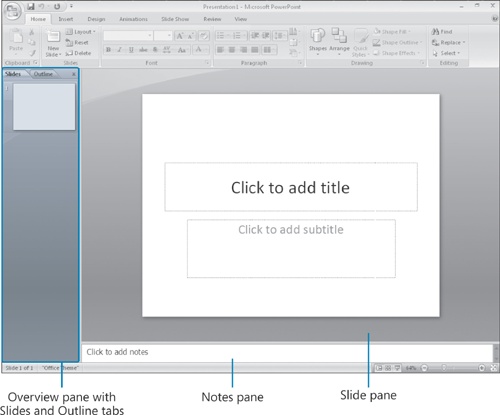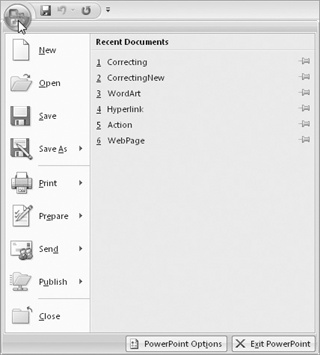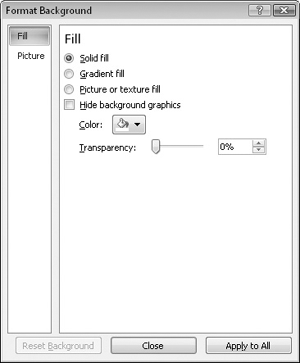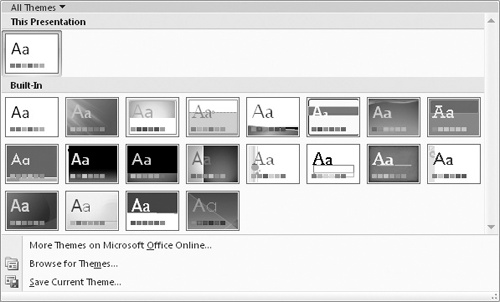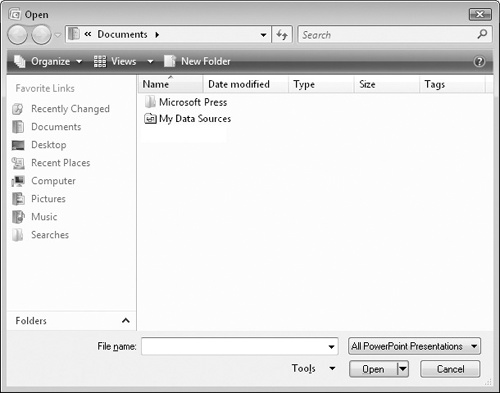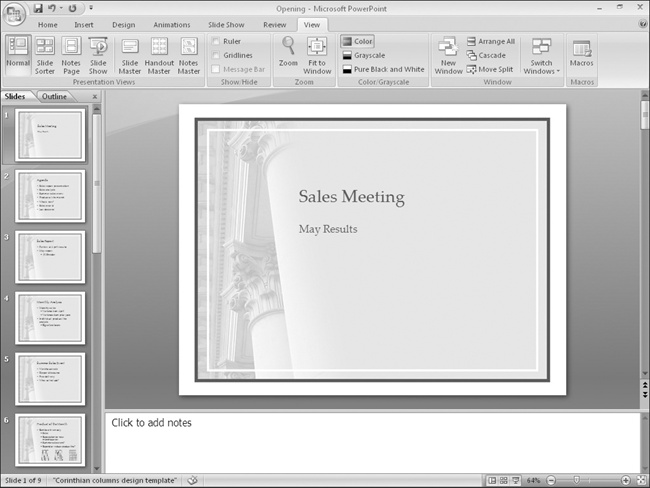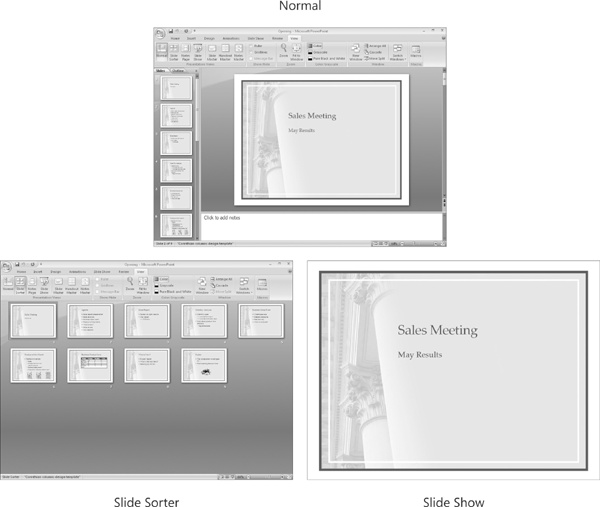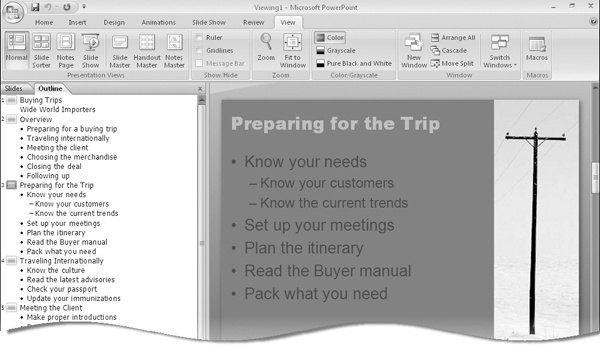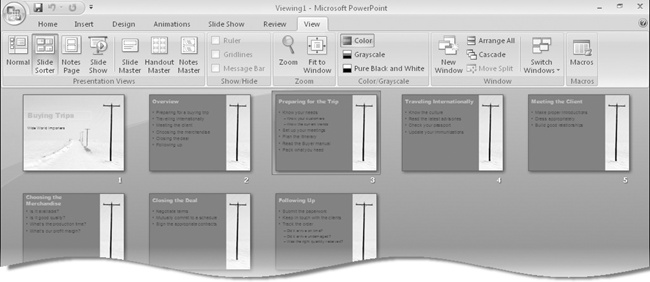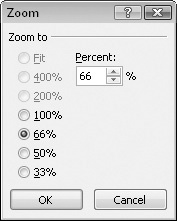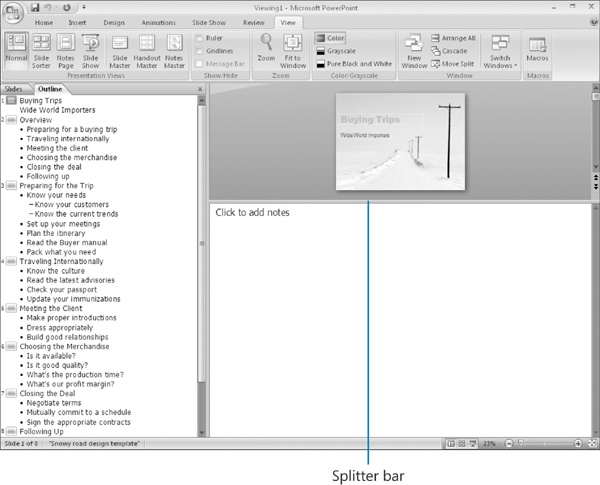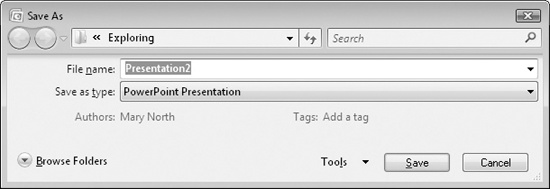Chapter at a Glance
Using Microsoft Office PowerPoint 2007 is the easiest way to efficiently create effective presentations. Need a slide show to convince management to invest in that new piece of equipment? Need to present the new annual budget to the Board of Directors? Need to give a report about a recent research study? PowerPoint can help you get the job done in a professional, visually appealing way.
PowerPoint 2007 uses the Microsoft Office Fluent user interface to make sophisticated features more accessible. As a result, even novice users will be able to work productively with PowerPoint after only a brief introduction.
In this chapter, you will first familiarize yourself with the new features of the PowerPoint working environment, including the Microsoft Office Button, tabs and groups, galleries, and Live Preview. Then you will open an existing PowerPoint presentation, learn ways of moving around in it, and close it. You will explore various ways of viewing slides so that you know which view to use for different tasks and how to tailor the program window to meet your needs. Finally, you will save a new blank presentation and then save an existing presentation with a new name.
Note
See Also Do you need only a quick refresher on the topics in this chapter? See the Quick Reference section at the beginning of this book.
Warning
Important Before you can use the practice files in this chapter, you need to install them from the book’s companion CD to their default location. See Using the Book’s CD at the beginning of this book for more information.
Note
Troubleshooting Graphics and operating system–related instructions in this book reflect the Windows Vista user interface. If your computer is running Windows XP and you experience trouble following the instructions as written, please refer to the Information for Readers Running Windows XP section at the beginning of this book.
As with all programs in the 2007 Microsoft Office release, the most common way to start PowerPoint is from the Start menu displayed when you click the Start button at the left end of the Windows taskbar. If PowerPoint is the first program in the 2007 Office system that you have used, you are in for a surprise! The look of the program window has changed radically from previous versions.
Warning
Important What you see on your screen might not match the graphics in this book exactly. The screens in this book were captured on a monitor set to a resolution of 1024 x 768 pixels with the Windows Vista Standard color scheme. The Windows taskbar is hidden to increase the space available for the program window.
The new Fluent user interface is designed to more closely reflect the way people generally work with the program. When you first start PowerPoint, this environment consists of the following elements:
Commands related to managing PowerPoint and PowerPoint presentations as a whole (rather than presentation content) are gathered together on a menu that is displayed when you click the Microsoft Office Button.
Commands can be represented as buttons on the Quick Access Toolbar to the right of the Microsoft Office Button. By default, this toolbar displays the Save, Undo, and Repeat buttons, but you can customize the toolbar to include any command that you use frequently.
Note
See Also For information about customizing the Quick Access Toolbar, see Making Favorite PowerPoint Commands Easily Accessible in Chapter 12.
The title bar displays the name of the active presentation. At the right end of the title bar are the three familiar buttons that have the same function in all Windows programs. You can temporarily hide the PowerPoint window by clicking the Minimize button, adjust the size of the window by clicking the Restore Down/Maximize button, and close a presentation or quit PowerPoint by clicking the Close button.
Below the title bar is the Ribbon, which makes all the capabilities of PowerPoint available in a single area so that you can work efficiently with the program.
Commands related to working with presentation content are represented as buttons on a set of tabs that make up the Ribbon. The Home tab is active by default. Clicking one of the other tabs, such as Insert, displays that tab’s buttons.
On each tab, buttons are organized into groups. Depending on the size of the program window, in some groups the button you are likely to use most often is bigger than the rest.
Related but less common tasks are not represented as buttons in the group; instead they are available in a dialog box, which you can display by clicking the dialog box launcher at the right end of the group’s title bar.
Some button names are displayed and some aren’t. Pointing to any button for a few seconds displays a ScreenTip with not only the button’s name but also its function.
Some buttons have arrows, but not all arrows are alike. If you point to a button and both the button and its arrow are in the same box and are the same color, clicking the button will display options for refining the action of the button. If you point to a button and the button is in one box and its arrow is in a different box with a different shade, clicking the button will carry out that action with the button’s current settings. If you want to change those settings, you need to click the arrow to see the available options.
The Microsoft Office PowerPoint Help button sits at the right end of the Ribbon.
Across the bottom of the program window, the status bar gives you information about the current presentation. You can turn off the display of an item of information by right-clicking the status bar and then clicking the item you want to turn off.
At the right end of the status bar is the View toolbar, which provides tools for adjusting the view of presentation content.
Note
See Also For information about adjusting the view of a document, see Displaying Different Views of a Presentation later in this chapter.
You can display the content of the active presentation in three primary views: Normal view, Slide Sorter view, and Slide Show view. You carry out most of the development work on a presentation in Normal view, which is the default.
Normal view consists of three panes:
Overview pane. Contains two tabs: the Slides tab, which displays small images called thumbnails of all the slides in the active presentation; and the Outline tab, which shows all the text on the slides displayed as an outline.
Slide pane. Shows the currently selected slide as it will appear in the presentation.
Notes pane. Provides a place for entering notes about the current slide. These notes might be related to the development of the slide or they might be speaker notes that you will refer to when delivering the presentation.
The goal of the redesigned PowerPoint environment is to make the process of creating a presentation more intuitive. Commands for tasks you perform often are no longer hidden on menus and in dialog boxes, and features you might not have discovered before are now more visible.
For example, when a formatting option has several choices available, they are often displayed in a gallery of thumbnails. These galleries give you an at-a-glance picture of each option. If you point to a thumbnail in a gallery, an awesome new feature called Live Preview shows you what that choice will look like if you apply it to your presentation.
In this exercise, you will start PowerPoint and explore the Microsoft Office Button and the tabs and groups on the Ribbon. Along the way, you will see how to take advantage of galleries and Live Preview. There are no practice files for this exercise.
On the taskbar, click the Start button, point to All Programs, click Microsoft Office, and then click Microsoft Office PowerPoint 2007.
The PowerPoint program window opens, displaying a blank presentation. If your program window is not maximized, maximize it now.
Click the Microsoft Office Button.
Commands related to managing presentations (such as creating, saving, and printing) are available from the menu that appears. This menu, which we refer to throughout this book as the Office menu, takes the place of the File menu that appeared in previous versions of PowerPoint.
The commands on the left are for tasks related to the presentation as a whole. After you work with a presentation, its name appears in the Recent Documents list so that you can quickly open it again. At the bottom of the menu are buttons for changing program options and for quitting PowerPoint.
Note
See Also For information about changing program options, see Chapter 12.
Press the
 key to close the menu.
key to close the menu.On the Ribbon, the Home tab is active. Buttons related to creating slide content are organized on this tab in six groups: Clipboard, Slides, Font, Paragraph, Drawing, and Editing. Only the buttons representing commands that can be performed on the currently selected presentation element are active.
Point to the active buttons on this tab to display the ScreenTips that name them and describe their functions.
Warning
Important Depending on your screen resolution and the size of the program window, you might see more or fewer buttons in each of the groups, or the buttons you see might be represented by larger or smaller icons than those shown in this book. Experiment with the size of the program window to understand the effect on the appearance of the command interface tabs.
Click the Insert tab, and then explore its buttons.
Buttons related to all the items you can insert are organized on this tab in five groups: Tables, Illustrations, Links, Text, and Media Clips.
Click the Design tab, and then explore its buttons.
Buttons related to the appearance of your presentation are organized on this tab in three groups: Page Setup, Themes, and Background.
In the Background group, display the ScreenTip for the Hide Background Graphics button.
The ScreenTip tells you that the button hides the background graphic that is part of the selected theme.
At the right end of the Background group’s title bar, click the Background dialog box launcher.
The Format Background dialog box opens.
In this dialog box, you set the slide background. You can fill the background with a solid color, color gradient, or picture, and you can hide the background graphic associated with the selected theme.
In the Format Background dialog box, click Close.
In the Themes group, point to (but don’t click) the third theme thumbnail from the left.
In the Slide pane, PowerPoint displays a live preview of what the slide will look like if you click this theme thumbnail. You can see the effect of the selection without actually applying the effect.
In the scroll bar to the right of the thumbnails in the Themes group, click the scroll down arrow.
The next row of theme thumbnails scrolls into view.
In the Themes group, click the More button.
Point to various themes in the gallery, observing the effect on the slide.
Click the Animations tab, and then explore its buttons, gallery, and live previews.
Buttons related to slide animation are organized on this tab in three groups: Preview, Animations, and Transition To This Slide.
Click the Slide Show tab, and then explore its buttons.
Buttons related to displaying your presentation are organized on this tab in three groups: Start Slide Show, Set Up, and Monitors.
Click the Review tab, and then explore its buttons.
Buttons related to comments, changes, and editorial tools are organized on this tab in three groups: Proofing, Comments, and Protect.
Click the View tab, and then explore its buttons.
Buttons related to changing the view or the display of the presentation are organized on this tab in five groups: Presentation Views, Show/Hide, Zoom, Color/Grayscale, Window, and Macros.
To open an existing presentation, you click the Microsoft Office Button and then click Open to display the Open dialog box. The first time you use this command, the Open dialog box displays the contents of your Documents folder. If you display the dialog box again in the same PowerPoint session, it displays the contents of whatever folder you last used. To see the contents of a different folder, you use standard Windows techniques. After you locate the file you want to work with, you can double-click it to open it.
Tip
Clicking a file name and then clicking the Open arrow in the lower-right corner of the Open dialog box displays a list of alternative ways to open the selected file. To look through the presentation without making any inadvertent changes, you can open the file as read-only, or you can open an independent copy of the file. You can open a file in a Web browser. In the event of a computer crash or other similar incident, you can tell PowerPoint to open the file and attempt to repair any damage.
When a presentation is open, you can move from slide to slide several ways, including the following:
If more than one presentation is open, you can close the active presentation by clicking the Close button at the right end of the title bar. If only one presentation is open, clicking the Close button closes the presentation and also quits PowerPoint. If you want to close the presentation but leave PowerPoint open, you must click the Microsoft Office Button and then click Close.
In this exercise, you will open an existing presentation and explore various ways of moving around in it. Then you will close the presentation.
Note
USE the Opening presentation. This practice file is located in the DocumentsMicrosoft PressPowerPoint2007SBSExploring folder.
BE SURE TO start PowerPoint before beginning this exercise.
Click the Microsoft Office Button, and then click Open.
The Open dialog box opens, showing the contents of the folder you used for your last open or save action.
If the contents of the Exploring folder are not displayed, in the Navigation Pane, click Documents. Then double-click the Microsoft Press folder, double-click the PowerPoint2007SBS folder, and double-click the Exploring folder.
Double-click the Opening file to open it.
The Opening presentation opens in the PowerPoint program window.
In the Overview pane, on the Slides tab, click Slide 3.
At the bottom of the scroll bar on the right side of the Slide pane, click the Next Slide button to move to Slide 4.
Drag the scroll box slowly down to the bottom of the scroll bar.
As you move down the scroll bar, a ScreenTip tells you the number and name of the slide that will be displayed if you release the mouse button at that point.
Click the Microsoft Office Button, and then click Close to close the presentation.
PowerPoint has three primary views (the views you will use most often) to help you create, organize, and display presentations:
In Normal view, you can work with a presentation in four ways: with a set of slide thumbnails on the Slides tab of the Overview pane; with a text outline on the Outline tab of the Overview pane; with a slide in the Slide pane; and with development and delivery notes in the Notes pane.
Note
See Also For information about working with text on the Outline tab and in the Slide pane, see Entering Text and Editing Text in Chapter 3. For information about working with notes, see Preparing Speaker Notes and Handouts in Chapter 10.
In Slide Sorter view, the slides of the presentation are displayed as thumbnails so that you can easily reorganize them. You can also animate the transition from one slide to another in this view, as well as specify how long each slide should remain on the screen.
Note
See Also For information about changing the order of slides, see Rearranging Slides in a Presentation in Chapter 4. For information about applying transitions, see Adding Transition Effects in Chapter 7.
In Slide Show view, each slide fills the screen. You use this view to preview the presentation and deliver it to an audience.
Note
See Also For information about adding slide timings and delivering an electronic presentation PowerPoint slide show, see Chapter 10.
You can switch among these views by clicking the buttons on the View toolbar at the right end of the status bar.
Alternatively, you can click the buttons in the Presentation Views group on the View tab. This group also includes buttons for the following views, which you will probably use less frequently:
You can add fancy speaker notes in Notes Page view. Although you can add speaker notes in the Normal view’s Notes pane, you must be in Notes Page view if you want to add graphics to your notes.
Note
See Also For information about creating more elaborate notes, see Preparing Speaker Notes and Handouts in Chapter 10.
You can control the default look of a presentation by working with the masters displayed in the Slide Master view, Handout Master view, or Notes Master view.
Note
See Also For information about masters, see Viewing and Changing a Presentation’s Master Slides in Chapter 9.
You can use other buttons on the View tab to display rulers and gridlines to help you position and align slide elements, to change the magnification of the current slide, to see how a colored slide will look if rendered in black and white (usually for printing), to arrange and work with windows, and to view macros.
Tip
You can adjust the magnification of the current slide by using tools on the View toolbar at the right end of the status bar. Click the Zoom button and select (or type) a percentage; drag the slider to the left or right; click the Zoom Out or Zoom In button at either end of the slider; or click the Fit Slide To Current Window button.
When you are working in Normal view, you can adjust the relative sizes of the panes to suit your needs by dragging the splitter bar that separates them. When you point to a splitter bar, the pointer changes to a double bar with opposing arrows, and you can drag in either direction. You can hide a pane by dragging the splitter bar to shrink the pane as far as it will go. Simply drag the splitter bar back to widen the pane again. If you adjust the width of the Slides tab in the Overview pane, the size of the slide thumbnails is adjusted accordingly—that is, you can see more small thumbnails in a narrow pane and fewer large thumbnails in a wide pane.
Tip
Any changes you make to a view, such as adjusting the sizes of panes, are saved with the presentation that is open at the time and do not affect other presentations.
In this exercise, you will switch among different PowerPoint views and adjust the slide size. You will view a presentation as a slide show and then return to Normal view, where you will adjust the size of the panes. Finally, you will see how to display more than one presentation at the same time.
Note
USE the Viewing1 and Viewing2 presentations. These practice files are located in the DocumentsMicrosoft PressPowerPoint2007SBSExploring folder.
OPEN the Viewing1 presentation.
In the Overview pane, click the Outline tab.
The pane switches from showing thumbnails of the slides to showing an outline of the text of the presentation.
On the Outline tab, click the title for Slide 3.
Slide 3 of the presentation is now shown in the adjacent Slide pane.
On the View tab, in the Presentation Views group, click the Slide Sorter button.
All the slides now appear as thumbnails in one large pane. Slide 3 is surrounded by a border, indicating that it is selected.
Hold down the
 key, point to any slide, and then press and hold the mouse button.
key, point to any slide, and then press and hold the mouse button.While you hold down the mouse button, only the slide’s title is visible against a white background, making it easier to locate the slide you want.
Release the
 key and the mouse button to restore the display of formatting.
key and the mouse button to restore the display of formatting.In the Zoom dialog box, click 100%, and then click OK.
Notice that the Zoom percentage on the View toolbar at the right end of the status bar also changes, and the slider moves all the way to the right.
Double-click Slide 1.
PowerPoint displays the presentation in Normal view, with Slide 1 active. Notice that the Zoom percentage in this view has not changed.
At the left end of the slider on the status bar, click the Zoom Out button twice.
Each time you click the button, the slider moves to the left and the Zoom percentage decreases.
At the right end of the slider, click the Zoom In button.
The Zoom percentage increases.
At the right end of the status bar, click the Fit slide to current window button.
PowerPoint restores the view to 64% (the original Zoom level).
On the View toolbar, click the Slide Show button.
PowerPoint displays a full-screen view of the first slide in the presentation.
Without moving your mouse, click its button to advance to the next slide.
Continue clicking the mouse button to advance through the presentation one slide at a time.
After the last slide in the presentation, PowerPoint displays a black slide.
Click again to return to Normal view.
Point to the splitter bar between the Slide pane and the Notes pane, and when the pointer changes to a double bar with opposing arrows, drag the bar down until the Notes pane is completely closed.
Drag the splitter bar at the bottom of the Slide pane upward as far as it will go.
Open the Viewing2 presentation from the Exploring folder under PowerPoint2007SBS.
On the View tab, in the Window group, click the Switch Windows button, and then click Viewing1.
Notice that customizing Normal view for one presentation does not affect Normal view for the other presentation.
In the Window group, click the Arrange All button.
In the workspace, you can now see both open presentations at the same time.
Experiment with the other commands in the Window group, and then at the right end of the Viewing2 title bar, click the Close button.
You can close a presentation this way only when more than one presentation is open.
At the right end of the Viewing1 title bar, click the Maximize button.
When you create a new presentation, it exists only in your computer’s memory until you save it. You save a presentation the first time by clicking the Save button on the Quick Access Toolbar or by clicking the Microsoft Office Button and then clicking Save. Either action opens the Save As dialog box, where you can assign a name and storage location.
If you want to save the document in a folder other than the one shown in the Address bar, you can click the chevrons to the left of the current folder name and then navigate to the folder you want. You can also click Browse Folders to display the Navigation Pane and a toolbar. If you want to create a new folder in which to store the file, you can click the New Folder button on this toolbar.
After you save a presentation for the first time, you can save changes simply by clicking the Save button. The new version of the presentation then overwrites the previous version. If you want to keep both the new version and the previous version, click Save As on the Office menu and then save a new version with a different name in the same location or with the same name in a different location. (You cannot have two files with the same name in the same folder.)
In this exercise, you will create a presentation and save it in a new folder. Then you will save the same presentation with the same name in a different folder. There are no practice files for this exercise.
Click the Microsoft Office Button, click New, and then in the New Presentation window, double-click Blank Presentation.
PowerPoint opens a new, blank presentation containing only a title slide.
On the Quick Access Toolbar, click the Save button.
The Save As dialog box opens, with the folder you last used in the Save As or Open dialog box in the Address bar.
If the Address bar does not display Exploring, navigate to that folder now.
If the Navigation Pane and toolbar are not displayed, click Browse Folders.
On the toolbar, click the New Folder button.
A folder named New Folder appears, with the name selected for editing.
Type My Presentations, and then press

My Presentations is now the current folder in the Save As dialog box.
In the File name box, click the existing entry, and then type My Presentation.
Note
Troubleshooting Programs that run on the Windows operating system use file name extensions to identify different types of files. For example, the extension .pptx identifies PowerPoint 2007 documents. Windows Vista programs do not display these extensions by default, and you shouldn’t type them in the Save As dialog box. When you save a file, PowerPoint automatically adds whatever extension is associated with the type of file selected in the Save As Type box.
Click Save to save the My Presentation file in the My Presentations folder.
Click the Microsoft Office Button, and then click Save As.
Tip
If you want to save the active presentation in a format that is compatible with previous versions of PowerPoint, click the Save As arrow, and then in the list, click PowerPoint 97-2003 Format to display the Save As dialog box with that format already selected in the Save As Type box.
The Save As dialog box opens, displaying the contents of the My Presentations folder.
In the Address bar, click Exploring.
The dialog box now displays the contents of the My Presentations folder’s parent folder, Exploring.
Click Save.
PowerPoint saves the My Presentation file in the Exploring folder. You have now saved two versions of the blank presentation with the same name, but in different folders.
Note
CLOSE the My Presentation file, and if you are not continuing directly on to the next chapter, quit PowerPoint.
Tip
By default, PowerPoint periodically saves the presentation you are working on in case the program stops responding or you lose electrical power. To adjust the time interval between saves, click the Microsoft Office Button, click PowerPoint Options, click Save in the left pane of the PowerPoint Options window, and specify the period of time in the box to the right of the Save AutoRecover Information Every check box. Then click OK.
Because the new PowerPoint interface makes commands easily accessible, you can quickly create sophisticated presentations.
You can move around a presentation in several ways: by clicking slide thumbnails on the Slides tab of the Overview pane; by clicking the Next Slide or Previous Slide button; by scrolling the Slide pane; or by pressing the Page Up or Page Down key.
PowerPoint has three primary views to help you create, organize, and display presentations: Normal, Slide Sorter, and Slide Show. You can switch views by clicking the buttons on the View toolbar or by clicking buttons in the Presentation Views group on the View tab.
In Normal view, you can change the magnification of your slides and the size of the panes to suit the way you work.
You can save a presentation in an existing folder or in a new folder that you can create from within PowerPoint. You cannot store two presentations with the same name in the same folder.

